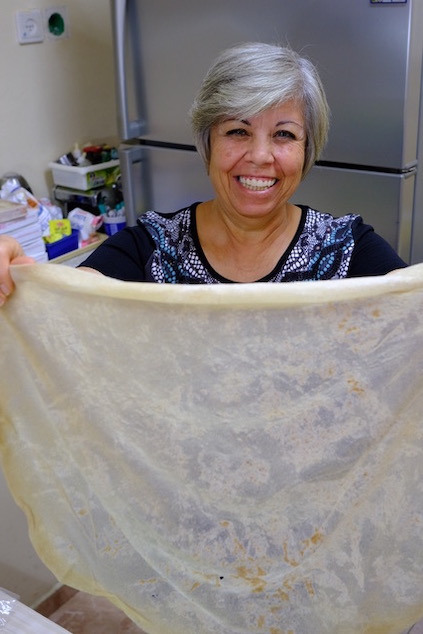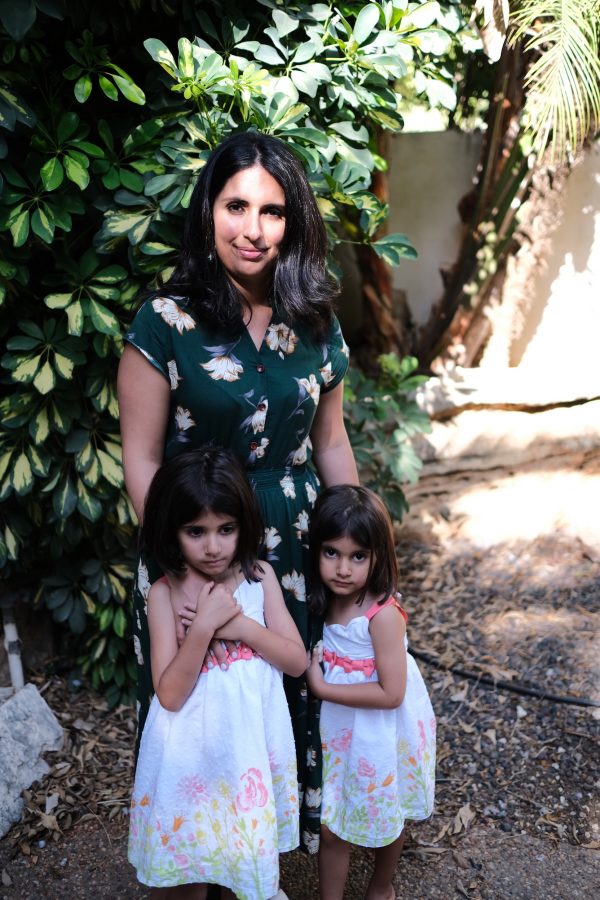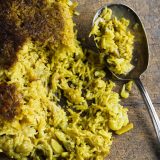The drive from Tel Aviv to Galilee is only 90 minutes heading northeast, but it is a bit like traveling from Barcelona to Basque country; they are a world apart. Tel Aviv is young, international, bursting with moonlit nightlife and electric scooters, meze and espresso, volleyball by the sea, and a freewheeling modernity drawn from a rich hunger for life instilled by geography. The West Bank divides Israel both physically and politically.
"She then jiggled the platter so the mound of rice started to crack open, revealing the meat and vegetables hidden inside."
As we head toward lunch with Reem Kassis, author of “The Palestinian Table,” the land is flat and stony, punctuated by crops of corn, mangos and grapes. The light is thin and bright, the sightlines long and clear. Small, ancient towns hug the slopes of hills, sketched in black and white, bleached by sun and time. We are traveling to Karmiel, a ’60s settlement with immaculate tree-lined suburban streets, where Kassis’ extended family wait to serve us a feast, dishes that would tell the story of the Palestinian table.
Maqlubeh is the recipe I most wanted to learn. It is a spiced rice and meat casserole with fried vegetables, nuts, eggplant and/or cauliflower that is cooked in a large pot, then flipped upside down onto a thin metal platter for serving. In fact, the term means “upside down” in Arabic. As I was about to learn, the platter is an essential piece of cookware in Galilee. Nothing is prepared in small quantities since extended family, friends and neighbors tend to drift into view just before serving.
The rice dish maqlubeh is cooked in a large pot, then flipped upside down for serving.
The dish starts with simmering the meat (lamb or chicken) in water, which also produces stock. The meat then is sautéed with onions and spices before a layer of rice is added, then fried eggplant, then a final layer of spiced rice and the broth. The spice mix can be a classic baharat, but Kassis points out that every family has their own recipe. Most spice blends in Arabic cooking start with allspice, cinnamon, black pepper and nutmeg.
Our van pulled up across the street from Kassis’ parents’ house, and much like a family reunion, the house emptied onto the sidewalk. We were greeted by her parents (Nisreen and Philip), her in-laws and her two daughters (Yasmeen and Hala). Soon, we were escorted inside to seats at a very long table; in Galilee, hospitality is paramount. The table already was dressed with an abundance of dishes, including a salad of arugula, mint, tomatoes and labneh balls, musakhan (spiced chicken wrapped in a flaky pastry dough), sfeeha (rounds of yeast dough filled with spiced lamb), bitter greens with caramelized onions, and stuffed vegetables served casserole-style with lamb cutlets.
More from Galilee
The Khalaf family uses two large stone wheels to press olives.
Taboon bread is served with an olive oil- za’atar paste. Its bumpy texture is a throwback to when it was baked with hot stones.

Leah Samman makes small, light shawarma rolls using see-through dough.
Bassam Qadri operates a mill next to a bakery, where grains are processed via an elaborate grinder/sorter system.
The last act was to unmold the maqlubeh, no mean feat since the pot is hot and heavy. Using kitchen towels, Kassis placed the platter on top of the pot, then, with a sure hand, flipped them over and lifted the pot off. She then jiggled the platter so the mound of rice started to crack open, revealing the meat and vegetables hidden inside. Lighter than I would have imagined, the spices, rice, meat and eggplant make this a classic feast dish, the mix of ingredients varied in both texture and flavor, and one that provides excellent leftovers.
I soon discovered that maqlubeh is a good ambassador for the Palestinian table. If you ask a resident of Tel Aviv about where to eat, they might mention their great Thai food. An Arab resident of Galilee is more likely to offer tradition. That may be because Tel Aviv imports many of its ingredients, whereas Palestinian food in Galilee still is intimately connected with the land. Olive oil is pressed using a machine that consists of two giant stone crushing wheels set in an ancient red container that looks like a washed-up dinghy. Grains are processed with a Rube Goldberg grinder/sorter. And taboon bread is baked in a rotating circular oven that has metal bumps on the surface to mimic the hot stones traditionally used.
And then, as we descend from the hills toward sunset, toward our hotel, the Sea of Galilee appears as a biblical still life, without sound or movement, the Golan Heights ebbing into the night across the water. Much like the landscape, a rocky desert punctuated by the rich greens of irrigated farmland, Palestinian food is enduring and hearty, yet more than able to deliver a culinary surprise without warning. A fragrant rose petal jam; maftool, a form of fregola that starts with a grain of bulgur inside; ka’ak asfar, a sweet turmeric-colored bread with ground nigella and sesame seeds; or a simple pairing of bitter greens and grains. It is a cuisine of abundance in a land where ingredients are hard-won, scratched from an unforgiving landscape that has endured from the dawn of history.
Back at Milk Street, we had our work cut out for us to streamline this dish. We wanted a smaller recipe using chicken, not lamb, and less pre-cooking; we also hoped we could avoid frying the eggplant. We started by soaking the rice while we sautéed bone-in, skin-on chicken thighs, then set them aside. We then put a round of kitchen parchment on the bottom of the pot to make the finished dish easier to unmold. We added oil and almonds, then a cup of the rice. The remaining rice was mixed with spices, garlic and cauliflower florets. Most of this was layered into the pot, followed by a layer of chicken, then slices of eggplant (raw, not fried) and a final thin layer of the seasoned rice followed by broth.
We cooked the mixture on the stovetop for about 40 minutes, then let it rest for 15 minutes off the heat before unmolding. For the less adventurous, the dish can be served directly from the pot without flipping to invert it onto a platter. Now we had a family-, not feast-sized, version of maqlubeh, one that could be assembled quickly while maintaining the original flavors and traditions of Galilee.

Reem Kassis says every household has their own spice blend, a mix that is used daily. And she shared her family’s recipe, though we suggest you customize your own all-purpose blend. Kassis calls for 6 tablespoons allspice, 6 cinnamon sticks (broken in half), 3 tablespoons coriander seed, 1 tablespoon black peppercorns, 10 whole cloves, ½ whole nutmeg(crushed), 1 teaspoon cardamom seeds, ½ teaspoon cumin seedsand 2 blades mace. Toast all ingredients in a skillet until aromatic, stirring frequently, 8 to 10 minutes. Use a spice grinder to grind to a powder. Makes about 1 cup. Keeps for three months in an airtight container. If you don’t have blades of mace, stir in ground mace after grinding.
Related Recipes
January-February 2020

Sign up to receive texts
Successfully signed up to receive texts!
We'll only send our very best offers - Like a $15 store credit to start.
By entering your phone number and submitting this form, you consent to receive marketing text messages (such as promotion codes and cart reminders) from Christopher Kimball's Milk Street at the number provided, including messages sent by autodialer. Consent is not a condition of any purchase. Message and data rates may apply. Message frequency varies. You can unsubscribe at any time by replying STOP or clicking the unsubscribe link (where available) in one of our messages. View our Privacy Policy and Terms of Service.



